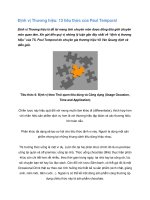Paul wilmott introduces quantitative finance
Bạn đang xem bản rút gọn của tài liệu. Xem và tải ngay bản đầy đủ của tài liệu tại đây (35.16 MB, 777 trang )
Contents
Cover
Half Title page
Title page
Copyright page
Dedication
Preface
Chapter 1: Products and Markets: Equities, Commodities,
Exchange Rates, Forwards and Futures
1.1 Introduction
1.2 Equities
1.3 Commodities
1.4 Currencies
1.5 Indices
1.6 The Time Value of Money
1.7 Fixed-Income Securities
1.8 Inflation-Proof Bonds
1.9 Forwards and Futures
1.10 More About Futures
1.11 Summary
Further Reading
Exercises
Chapter 2: Derivatives
2.1 Introduction
2.2 Options
2.3 Definition of Common Terms
2.4 Payoff Diagrams
2.5 Writing Options
2.6 Margin
2.7 Market Conventions
2.8 The Value of the Option Before Expiry
2.9 Factors Affecting Derivative Prices
2.10 Speculation and Gearing
2.11 Early Exercise
2.12 Put-Call Parity
2.13 Binaries or Digitals
2.14 Bull and Bear Spreads
2.15 Straddles and Strangles
2.16 Risk Reversal
2.17 Butterflies and Condors
2.18 Calendar Spreads
2.19 Leaps and Flex
2.20 Warrants
2.21 Convertible Bonds
2.22 Over the Counter Options
2.23 Summary
Further Reading
Exercises
Chapter 3: The Binomial Model
3.1 Introduction
3.2 Equities Can Go Down as Well as Up
3.3 The Option Value
3.4 Which Part of Our ‘Model’ didn’t We Need!
3.5 Why should this ‘Theoretical Price’ be the ‘Market Price’?
3.6 How did I Know to Sell 1/2 of the Stock for Hedging?
3.7 How does this Change if Interest Rates are Non-Zero!
3.8 Is the Stock Itself Correctly Priced!
3.9 Complete Markets
3.10 The Real and Risk-Neutral Worlds
3.11 And Now Using Symbols
3.12 An Equation for the Value of an Option
3.13 Where did the Probability p Go!
3.14 Counter-Intuitive?
3.15 The Binomial Tree
3.16 The Asset Price Distribution
3.17 Valuing Back Down the Tree
3.18 Programming the Binomial Method
3.19 The Greeks
3.20 Early Exercise
3.21 The Continuous-Time Limit
3.22 Summary
Further Reading
Welcome to My World
Appendix: Another Parameterization
Exercises
Chapter 4: The Random Behavior of Assets
4.1 Introduction
4.2 The Popular Forms of ‘Analysis’
4.3 Why We Need A Model for Randomness: Jensen’s Inequality
4.4 Similarities Between Equities, Currencies, Commodities and
Indices
4.5 Examining Returns
4.6 Timescales
4.7 Estimating Volatility
4.8 The Random Walk on a Spreadsheet
4.9 The Wiener Process
4.10 The Widely Accepted Model for Equities, Currencies,
Commodities and Indices
4.11 Summary
Further Reading
Exercises
Chapter 5: Elementary Stochastic Calculus
5.1 Introduction
5.2 A Motivating Example
5.3 The Markov Property
5.4 The Martingale Property
5.5 Quadratic Variation
5.6 Brownian Motion
5.7 Stochastic Integration
5.8 Stochastic Differential Equations
5.9 The Mean Square Limit
5.10 Functions of Stochastic Variables and Itô’s Lemma
5.11 Interpretation of Itô’s Lemma
5.12 Itô and Taylor
5.13 Itô in Higher Dimensions
5.14 Some Pertinent Examples
5.15 Summary
Further Reading
Exercises
Chapter 6: The Black–Scholes Model
6.1 Introduction
6.2 A Very Special Portfolio
6.3 Elimination of Risk: Delta Hedging
6.4 No Arbitrage
6.5 The Black–Scholes Equation
6.6 The Black–Scholes Assumptions
6.7 Final Conditions
6.8 Options on Dividend-Paying Equities
6.9 Currency Options
6.10 Commodity Options
6.11 Expectations and Black–Scholes
6.12 Some Other Ways of Deriving the Black-Scholes Equation
6.13 No Arbitrage in the Binomial, Black–Scholes and ‘Other’
Worlds
6.14 Forwards and Futures
6.15 Futures Contracts
6.16 Options on Futures
6.17 Summary
Further Reading
Exercises
Chapter 7: Partial Differential Equations
7.1 Introduction
7.2 Putting the Black–Scholes Equation into Historical Perspective
7.3 The Meaning of the Terms in the Black–Scholes Equation
7.4 Boundary and Initial/Final Conditions
7.5 Some Solution Methods
7.6 Similarity Reductions
7.7 Other Analytical Techniques
7.8 Numerical Solution
7.9 Summary
Further Reading
Exercises
Chapter 8: The Black–Scholes Formulae and the Greeks’
8.1 Introduction
8.2 Derivation of the Formulæ for Calls, Puts and Simple Digitals
8.3 Delta
8.4 Gamma
8.5 Theta
8.6 Speed
8.7 Vega
8.8 Rho
8.9 Implied Volatility
8.10 A Classification of Hedging Types
8.11 Summary
Further Reading
Exercises
Chapter 9: Overview of Volatility Modeling
9.1 Introduction
9.2 The Different Types of Volatility
9.3 Volatility Estimation by Statistical Means
9.4 Maximum Likelihood Estimation
9.5 Skews and Smiles
9.6 Different Approaches to Modeling Volatility
9.7 The Choices of Volatility Models
9.8 Summary
Further Reading
Appendix: How to Derive BS PDE, Minimum Fuss
Exercises
Chapter 10: How to Delta Hedge
10.1 Introduction
10.2 What if Implied and Actual Volatilities are Different?
10.3 Implied Versus Actual, Delta Hedging but Using Which
Volatility?
10.4 Case I: Hedge with Actual Volatility, σ
10.5 Case 2: Hedge with Implied Volatility,
10.6 Hedging with Different Volatilities
10.7 Pros and Cons of Hedging with Each Volatility
10.8 Portfolios when Hedging with Implied Volatility
10.9 How Does Implied Volatility Behave!
10.10 Summary
Further Reading
Exercises
Chapter 11: An Introduction to Exotic and Path-Dependent
Options
11.1 Introduction
11.2 Option Classification
11.3 Time Dependence
11.4 Cashflows
11.5 Path Dependence
11.6 Dimensionality
11.7 The Order of an Option
11.8 Embedded Decisions
11.9 Classification Tables
11.10 Examples of Exotic Options
11.11 Summary of Math/Coding Consequences
11.12 Summary
Further Reading
Some Formulæ for Asian Options
Some Formulæ for Lookback Options
Exercises
Chapter 12: Multi-Asset Options
12.1 Introduction
12.2 Multidimensional Lognormal Random Walks
12.3 Measuring Correlations
12.4 Options on Many Underlyings
12.5 The Pricing Formula for European Non-Path-Dependent
Options on Dividend-Paying Assets
12.6 Exchanging one Asset for Another: A Similarity Solution
12.7 Two Examples
12.8 Realities of Pricing Basket Options
12.9 Realities of Hedging Basket Options
12.10 Correlation Versus Cointegration
12.11 Summary
Further Reading
Exercises
Chapter 13: Barrier Options
13.1 Introduction
13.2 Different Types of Barrier Options
13.3 Pricing Methodologies
13.4 Pricing Barriers in The Partial Differential Equation
Framework
13.5 Examples
13.6 Other Features in Barrier-Style Options
13.7 Market Practice: What Volatility Should I Use?
13.8 Hedging Barrier Options
13.9 Summary
Further Reading
Exercises
Chapter 14: Fixed-Income Products and Analysis: Yield, Duration
and Convexity
14.1 Introduction
14.2 Simple Fixed-Income Contracts and Features
14.3 International Bond Markets
14.4 Accrued Interest
14.5 Day-Count Conventions
14.6 Continuously and Discretely Compounded Interest
14.7 Measures of Yield
14.8 The Yield Curve
14.9 Price/Yield Relationship
14.10 Duration
14.11 Convexity
14.12 An Example
14.13 Hedging
14.14 Time-Dependent Interest Rate
14.15 Discretely Paid Coupons
14.16 Forward Rates and Bootstrapping
14.17 Interpolation
14.18 Summary
Further Reading
Exercises
Chapter 15: Swaps
15.1 Introduction
15.2 The Vanilla Interest Rate Swap
15.3 Comparative Advantage
15.4 The Swap Curve
15.5 Relationship Between Swaps and Bonds
15.6 Bootstrapping
15.7 Other Features of Swaps Contracts
15.8 Other Types of Swap
15.9 Summary
Further Reading
Exercises
Chapter 16: One-Factor Interest Rate Modeling
16.1 Introduction
16.2 Stochastic Interest Rates
16.3 The Bond Pricing Equation for the General Model
16.4 What is the Market Price of Risk?
16.5 Interpreting the Market Price of Risk, and Risk Neutrality
16.6 Named Models
16.7 Equity and Fx Forwards and Futures When Rates are
Stochastic
16.8 Futures Contracts
16.9 Summary
Further Reading
Exercises
Chapter 17: Yield Curve Fitting
17.1 Introduction
17.2 Ho & Lee
17.3 The Extended Vasicek Model of Hull & White
17.4 Yield-Curve Fitting: for and Against
17.5 Other Models
17.6 Summary
Further Reading
Exercises
Chapter 18: Interest Rate Derivatives
18.1 Introduction
18.2 Callable Bonds
18.3 Bond Options
18.4 Caps and Floors
18.5 Range Notes
18.6 Swaptions, Captions and Floortions
18.7 Spread Options
18.8 Index Amortizing Rate Swaps
18.9 Contracts with Embedded Decisions
18.10 Some Examples
18.11 More Interest Rate Derivatives …
18.12 Summary
Further Reading
Exercises
Chapter 19: The Heath, Jarrow & Morton and Brace, Gatarek &
Musiela Models
19.1 Introduction
19.2 The Forward Rate Equation
19.3 The Spot Rate Process
19.4 The Market Price of Risk
19.5 Real and Risk Neutral
19.6 Pricing Derivatives
19.7 Simulations
19.8 Trees
19.9 The Musiela Parameterization
19.10 Multi-Factor HJM
19.11 Spreadsheet Implementation
19.12 A Simple one-Factor Example: Ho & Lee
19.13 Principal Component Analysis
19.14 Options on Equities, Etc.
19.15 Non-Infinitesimal Short Rate
19.16 The Brace, Gatarek & Musiela Model
19.17 Simulations
19.18 Pving the Cashflows
19.19 Summary
Further Reading
Exercises
Chapter 20: Investment Lessons from Blackjack and Gambling
20.1 Introduction
20.2 The Rules of Blackjack
20.3 Beating the Dealer
20.4 The Distribution of Profit in Blackjack
20.5 The Kelly Criterion
20.6 Can You win at Roulette?
20.7 Horse Race Betting and no Arbitrage
20.8 Arbitrage
20.9 How to Bet
20.10 Summary
Further Reading
Exercises
Chapter 21: Portfolio Management
21.1 Introduction
21.2 Diversification
21.3 Modern Portfolio Theory
21.4 Where do I Want to be on the Efficient Frontier?
21.5 Markowitz in Practice
21.6 Capital Asset Pricing Model
21.7 The Multi-Index Model
21.8 Cointegration
21.9 Performance Measurement
21.10 Summary
Further Reading
Exercises
Chapter 22: Value at Risk
22.1 Introduction
22.2 Definition of Value at Risk
22.3 VaR for a Single Asset
22.4 VaR for a Portfolio
22.5 VaR for Derivatives
22.6 Simulations
22.7 Use of VaR as a Performance Measure
22.8 Introductory Extreme Value Theory
22.9 Coherence
22.10 Summary
Further Reading
Exercises
Chapter 23: Credit Risk
23.1 Introduction
23.2 The Merton Model: Equity as an Option on a Company’s
Assets
23.3 Risky Bonds
23.4 Modeling the Risk of Default
23.5 The Poisson Process and the Instantaneous Risk of Default
23.6 Time-Dependent Intensity and the Term Structure of Default
23.7 Stochastic Risk of Default
23.8 Positive Recovery
23.9 Hedging the Default
23.10 Credit Rating
23.11 A Model For Change of Credit Rating
23.12 Copulas: Pricing Credit Derivatives with Many Underlyings
23.13 Collateralized Debt Obligations
23.14 Summary
Further Reading
Exercises
Chapter 24: RiskMetrics and Credit Metrics
24.1 Introduction
24.2 The Riskmetrics Datasets
24.3 Calculating the Parameters the Riskmetrics Way
24.4 The Creditmetrics Dataset
24.5 The Creditmetrics Methodology
24.6 A Portfolio of Risky Bonds
24.7 Creditmetrics Model Outputs
24.8 Summary
Further Reading
Chapter 25: CrashMetrics
25.1 Introduction
25.2 Why do Banks Go Broke?
25.3 Market Crashes
25.4 Crashmetrics
25.5 Crashmetrics for One Stock
25.6 Portfolio Optimization and the Platinum Hedge
25.7 The Multi-Asset/Single-Index Model
25.8 Portfolio Optimization and the Platinum Hedge in the MultiAsset Model
25.9 The Multi-Index Model
25.10 Incorporating Time Value
25.11 Margin Calls and Margin Hedging
25.12 Counterparty Risk
25.13 Simple Extensions to Crashmetrics
25.14 The Crashmetrics Index (CMI)
25.15 Summary
Further Reading
Exercises
Chapter 26: Derivatives **** Ups
26.1 Introduction
26.2 Orange County
26.3 Proctor and Gamble
26.4 Metallgesellschaft
26.5 Gibson Greetings
26.6 Barings
26.7 Long-Term Capital Management
26.8 Summary
Further Reading
Chapter 27: Overview of Numerical Methods
27.1 Introduction
27.2 Finite-Difference Methods
27.3 Monte Carlo Methods
27.4 Numerical Integration
27.5 Summary
Further Reading
Chapter 28: Finite-Difference Methods for One-Factor Models
28.1 Introduction
28.2 Grids
28.3 Differentiation Using the Grid
28.4 Approximating θ
28.5 Approximating A
28.6 Approximating Γ
28.7 Example
28.8 Bilinear Interpolation
28.9 Final Conditions and Payoffs
28.10 Boundary Conditions
28.11 The Explicit Finite-Difference Method
28.12 The Code #1: European Option
28.13 The Code #2: American Exercise
28.14 The Code #3: 2-D Output
28.15 Upwind Differencing
28.16 Summary
Further Reading
Exercises
Chapter 29: Monte Carlo simulation
29.1 Introduction
29.2 Relationship Between Derivative Values and Simulations:
Equities, Indices, Currencies, Commodities
29.3 Generating Paths
29.4 Lognormal Underlying, No Path Dependency
29.5 Advantages of Monte Carlo Simulation
29.6 Using Random Numbers
29.7 Generating Normal Variables
29.8 Real Versus Risk Neutral, Speculation Versus Hedging
29.9 Interest Rate Products
29.10 Calculating the Greeks
29.11 Higher Dimensions: Cholesky Factorization
29.12 Calculation Time
29.13 Speeding Up Convergence
29.14 Pros and Cons of Monte Carlo Simulations
29.15 American Options
29.16 Longstaff & Schwartz Regression Approach for American
Options
29.17 Basis Functions
29.18 Summary
Further Reading
Exercises
Chapter 30: Numerical Integration
30.1 Introduction
30.2 Regular Grid
30.3 Basic Monte Carlo Integration
30.4 Low-Discrepancy Sequences
30.5 Advanced Techniques
30.6 Summary
Further Reading
Exercises
Appendix A: All the Math You Need… and No More (an Executive
Summary)
A.1 Introduction
A.2 e
A.3 log
A.4 Differentiation and Taylor Series
A.5 Differential Equations
A.6 Mean, Standard Deviation and Distributions
A.7 Summary
Appendix B: Forecasting the Markets?, A Small Digression
B.1 Introduction
B.2 Technical Analysis
B.3 Wave Theory
B.4 Other Analytics
B.5 Market Microstructure Modeling
B.6 Crisis Prediction
B.7 Summary
Further Reading
Appendix C: A Trading Game
C.1 Introduction
C.2 AIMS
C.3 Object of the Game
C.4 Rules of the Game
C.5 Notes
C.6 How to Fill in Your Trading Sheet
Appendix D: Contents of CD Accompanying Paul Wilmott
Introduces Quantitative Finance, Second Edition
Appendix E: What You Get if (When) You Upgrade to PWOQF2
Introduction
Bibliography
Index
Paul Wilmott
Introduces
Quantitative Finance
Second Edition
© 2007 Paul Wilmott
Published by John Wiley & Sons, Ltd
Registered office
John Wiley & Sons Ltd, The Atrium, Southern Gate, Chichester, West Sussex, PO19 8SQ, United
Kingdom
For details of our global editorial offices, for customer services and for information about how to
apply for permission to reuse the copyright material in this book please see our website at
www.wiley.com.
All rights reserved. No part of this publication may be reproduced, stored in a retrieval system, or
transmitted, in any form or by any means, electronic, mechanical, photocopying, recording or
otherwise, except as permitted by the UK Copyright, Designs and Patents Act 1988, without the prior
permission of the publisher.
Wiley publishes in a variety of print and electronic formats and by print-on-demand. Some material
included with standard print versions of this book may not be included in e-books or in print-ondemand. If this book refers to media such as a CD or DVD that is not included in the version you
purchased, you may download this material at . For more information
about Wiley products, visit www.wiley.com.
Designations used by companies to distinguish their products are often claimed as trademarks. All
brand names and product names used in this book are trade names, service marks, trademarks or
registered trademarks of their respective owners. The publisher is not associated with any product or
vendor mentioned in this book.
Limit of Liability/Disclaimer of Warranty: While the publisher and author have used their best efforts
in preparing this book, they make no representations or warranties with the respect to the accuracy or
completeness of the contents of this book and specifically disclaim any implied warranties of
merchantability or fitness for a particular purpose. It is sold on the understanding that the publisher is
not engaged in rendering professional services and neither the publisher nor the author shall be liable
for damages arising herefrom. If professional advice or other expert assistance is required, the
services of a competent professional should be sought.
Anniversary Logo Design: Richard J. Pacifico.
Library of Congress Cataloging-in-Publication Data
Wilmott, Paul.
Paul Wilmott introduces quantitative finance.—2nd ed.
p. cm.
ISBN 978-0-470-31958-1
1. Finance—Mathematical models. 2. Options (Finance)—Mathematical models. 3. Options
(Finance)—Prices—
Mathematical models. I. Title. II Title: Quantitative finance.
HG173.W493 2007
332—dc22
2007015893
A catalogue record for this book is available from the British Library.
ISBN 978-0-470-31958-1 (PB)
To a rising Star









